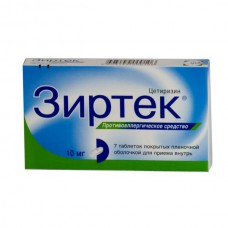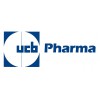Expiration date: 12/2026
Structure and Composition:
Tablets, film-coated. 1 tablet contains active substance: cetirizine dihydrochloride 10 mg
Excipients: MCC - 37 mg of lactose monohydrate - 66.4 mg Colloidal silicon dioxide - 0.6 mg magnesium stearate - 1.25 mg
shell: Opadry Y-1-7000 - 3,45 mg hypromellose (E464) - 2,156 mg titanium dioxide (E171) - 1,078 mg Macrogol 400 - 0,216 mg
in blister 7 or 10 pieces. 1 a cardboard pack (7 or 10 tablets) or 2 (10 tablets) blisters.
Drops for oral administration. 1 ml contains active substance: cetirizine hydrochloride 10 mg
Other ingredients: glycerol, - propylene glycol 250 mg - 350 mg Sodium saccharinate - 10 mg metilparabenzol - propilparabenzol 1.35 mg - 0.15 mg Sodium Acetate - 10 mg of glacial acetic acid - 0.53 mg Purified water - up to 1 ml
in vials-droppers of dark glass of 10 or 20 ml (1 ml = 20 drops) in paper cartons 1 bottle.
Description pharmaceutical form:
Tablets: White oblong, film-coated biconvex with surfaces, with one-sided risk and engraving «Y» on both sides of the risks.
Drops for reception inside: clear, colorless liquid with an odor of acetic acid.
Pharmacokinetics:
Pharmacokinetic parameters of cetirizine vary linearly.
Suction. After oral administration, the drug is rapidly and completely absorbed from the gastrointestinal tract. Food does not affect the completeness of absorption, although its speed is reduced. In adults, after a single dose Cmax of the drug in the therapeutic dose in plasma is 300 ng / ml and is achieved by (1 ± 0,5) h.
Distribution. Cetirizine at (93 ± 0,3)% bound to plasma proteins. Vd is 0.5 L / kg. Before the drug at a dose of 10 mg for 10 days cumulation of cetirizine is not observed.
Metabolism. In small quantities, it is metabolized in the body by O-dealkylation (unlike other antagonists of H1-histamine receptors which are metabolized in the liver via cytochrome systems) with a pharmacologically inactive metabolite.
Withdrawal. In adults, the T1 / 2 of approximately 10 hours in children aged 6 to 12 years - 6 hours, from 2 to 6 years - 5 hours, from 6 months to 2 years -. 3.1 hours Approximately 2/3 of the dose of the drug excreted by the kidneys unchanged.
In elderly patients and patients with chronic liver disease with single dose of the drug at a dose of 10 mg of T1 / 2 increased by about 50%, and systemic clearance is reduced by 40%.
In patients with renal insufficiency mild (Cl creatinine> 40 ml / min), the pharmacokinetic parameters are similar to those in patients with normal renal function.
In patients with renal insufficiency moderate severity in patients on hemodialysis (Cl creatinine <7 ml / min), when administered the drug in doses of 10 mg T1 / 2 is elongated by 3 times, and the total clearance is reduced by 70% relative to the patient with normal renal function, which requires a corresponding change in the dosing regime. Cetirizine virtually eliminated from the body during hemodialysis.
Description of the pharmacological actions:
Cetirizine - Zyrtec active ingredient of the drug - is a metabolite of hydroxyzine, refers to a group of competitive histamine antagonists and blocking of H1-histamine receptors. Cetirizine prevents the development and facilitates the allergic reactions, has antipruritic and protivoekssudativnoe action. Cetirizine gistaminozavisimuyu affects early stage of allergic reactions limits the release of inflammatory mediators at the late stage of an allergic reaction and also reduces the migration of eosinophils, neutrophils and basophils, mast cell stabilizing membrane. It reduces the permeability of capillaries, prevents tissue swelling, relieves smooth muscle spasm. Removes skin reaction to the introduction of histamine specific allergens and cooling (when cold urticaria). Reduces gistaminoindutsirovannuyu bronchoconstriction in asthma lung flow. Cetirizine is practically no anticholinergic and antiserotoninovogo action. At therapeutic doses, the drug has little sedative effect. Effect of cetirizine after receiving a single dose of 10 mg develops within 20 minutes (50% of patients), 60 min (95% of patients), and lasts more than 24 hours. In the course of treatment against tolerance cetirizine antihistaminic action does not develop. After discontinuation effect lasts up to 3 days.
Testimony:
For adults and children from 6 months of age and older:
- treatment of the symptoms of year-round and seasonal allergic rhinitis and allergic conjunctivitis (such as itching, sneezing, rhinorrhea, lacrimation, conjunctival hyperemia)
- hay fever (hay fever)
- urticaria, including chronic idiopathic urticaria
- angioedema
- allergic dermatosis, including atopic dermatitis, accompanied by itching and rash.
Contraindications:
- Common to all dosage forms
- Hypersensitivity to cetirizine, hydroxyzine or a piperazine derivative, as well as any of the components
- end-stage renal failure (creatinine clearance <10 mL / min)
- pregnancy
- during breastfeeding.
Precautions: chronic renal failure (moderate and severe degrees of severity required correction mode), older age (perhaps decreased glomerular filtration).
For tablets, film-coated, in addition:
- hereditary galactose intolerance, the lack of lactase, or syndrome of glucose-galactose malabsorption
- Children up to age 6 years.
Precautions: chronic liver disease.
For further drops:
Children up to age 6 months (mean of limited efficacy and safety data PM).
Precautions: epilepsy and patients with increased convulsive readiness for children under the age of 1 year.
Application of pregnancy and breastfeeding:
Experimental studies in animals did not reveal any direct or indirect adverse effects of cetirizine on the developing fetus (including the postnatal period), during pregnancy and childbirth are not changed.
Adequate and well-controlled clinical studies on the safety of the drug has not been so Zyrtec should not be used during pregnancy.
Cetirizine is excreted in breast milk, so the doctor has to decide the issue of termination of breastfeeding for the period of application of the drug.
Side effect:
Common to all dosage forms
Possible side effects are given below by body system and frequency of occurrence: very often (& ge1 / 10), often (& ge1 / 100 <1.10), rare (& ge1 / 1000 <1/100), rare (& ge1 / 10000, <1/1000), very rare (<1/10000) frequency not known (due to lack of data).
From the nervous system: often - headache, fatigue, dizziness, drowsiness, rarely - fatigue, paresthesia, agitation rare - aggression, confusion, hallucinations, depression, convulsions, insomnia very rare - dysgeusia, dyskinesia, dystonia, fainting, tremor, tic frequency is unknown - memory impairment, including amnesia.
From a sight organ: very rare - disturbance of accommodation, blurred vision, nystagmus.
From the digestive system: often - dry mouth, nausea, rarely - diarrhea, abdominal pain.
From the CCC: rarely - tachycardia.
With the respiratory system: often - rhinitis, pharyngitis.
On the part of metabolism: rarely - weight gain.
From the mochevydelitelnoy system: very rarely - dysuria, enuresis.
From the laboratory parameters: rarely - change of liver function tests (increased transaminases, alkaline phosphatase, GGT and bilirubin) very rarely - thrombocytopenia.
Allergic reactions: seldom - rash, pruritus rare - urticaria, hypersensitivity reactions are very rare - angioedema, anaphylactic shock, persistent erythema.
General disorders: rarely - discomfort rarely - peripheral edema.
Drug Interactions:
There were no pharmacokinetic interactions and clinical benefit with a joint appointment with pseudoephedrine, cimetidine, ketoconazole, erythromycin, azithromycin, diazepam, glipizide. When coadministered with theophylline at a dose of 400 mg 1 time per day was observed decline Cl creatinine 16%. At a joint appointment with the macrolides and ketoconazole is not marked ECG changes.
When used in therapeutic doses, no evidence of interaction with the alcohol (for BAC 0.5 g / L). Nevertheless, better to abstain from alcohol during treatment with cetirizine avoid CNS depression.
Before the appointment of allergy samples recommended a three-day "washout" period due to the fact that of H1-histamine receptor blockers inhibit the development of allergic skin reactions.
Dosage and administration:
Inside. Tablets should be washed down with a glass of liquid
Adults and children over 6 years: daily dose - 10 mg (1 tablet or 20 drops.), Sometimes starting dose of 5 mg (1/2 tab.) May be sufficient to achieve a therapeutic effect.
Children aged 6 to 12 months - 2.5 mg (5 drops), 1 time per day.
Children aged 1 to 2 years - 2.5 mg (5 drops) 2 times a day.
Children aged 2 to 6 years of age - 2.5 mg (5 drops), 2 times per day or 5 mg (10 drops) 1 time per day.
Patients with renal insufficiency dose decreases depending on creatinine clearance: Cl creatinine at 30-49 ml / min - 5 mg 1 time per day at 10-29 ml / min - 5 mg every other day.
Overdose:
Symptoms (while taking the drug once in a dose of 50 mg): confusion, diarrhea, dizziness, fatigue, headache, malaise, mydriasis, pruritus, fatigue, sedation, somnolence, stupor, tachycardia, tremor, urinary retention.
Treatment: Immediately after taking the drug - gastric lavage or induction of vomiting. It recommended the appointment of activated carbon, the holding of symptomatic and supportive therapy. No specific antidote. Hemodialysis is ineffective.
Special instructions:
Children from 6 months to 6 years Zyrtec drug administered in the form of drops for oral administration of 10 mg / ml.
For drops:
In view of the potential inhibitory effect on the CNS should be careful in appointing Zirteka children under the age of 1 year, subject to the following risk factors, such as the sudden infant death syndrome (but not limited to this list):
- Sleep apnea and sudden infant death syndrome in infants have a brother or sister
- Abuse of drugs or the mother smoking during pregnancy
- A young maternal age (19 years and younger)
- Abuse smoking babysitting, caring for a child (one pack of cigarettes per day or more)
- Children regularly falling asleep face down and which are not placed on the back
- Preterm (gestational age less than 37 weeks) or born underweight (below the 10th percentile of gestational age) children
- At a joint reception drugs that have a depressant effect on the central nervous system.
Requires compliance with caution, while the use of alcohol (see. "Interaction" section).
For all dosage forms
Effects on ability to drive vehicles and management mechanisms. When an objective assessment of the ability to drive vehicles and management mechanisms were not significantly reveal any adverse effects while taking the drug at the recommended dose. Nevertheless, during the period of ingestion it is advisable to refrain from activities potentially hazardous activities that require high concentration and psychomotor speed reactions.



